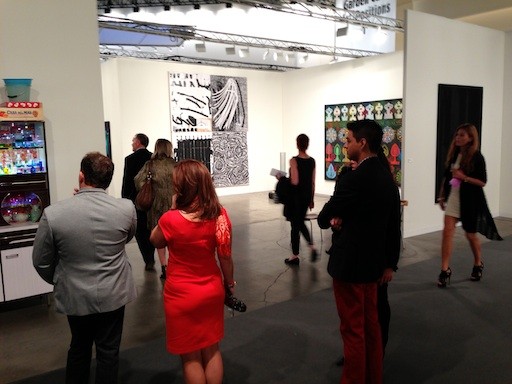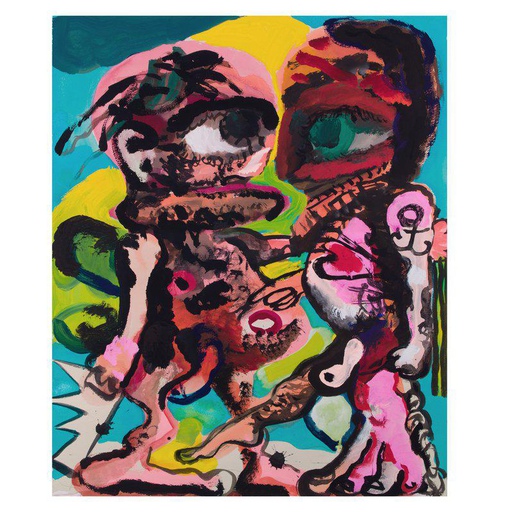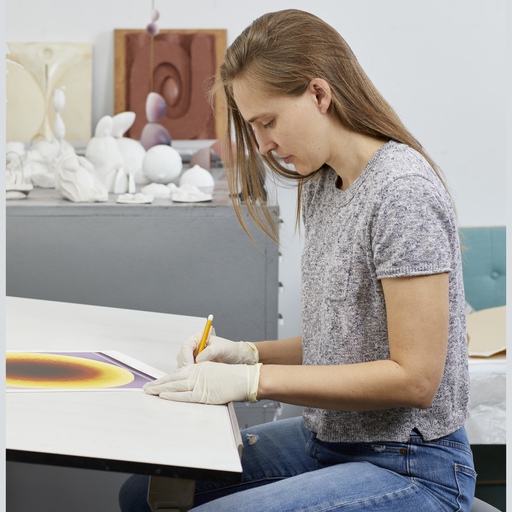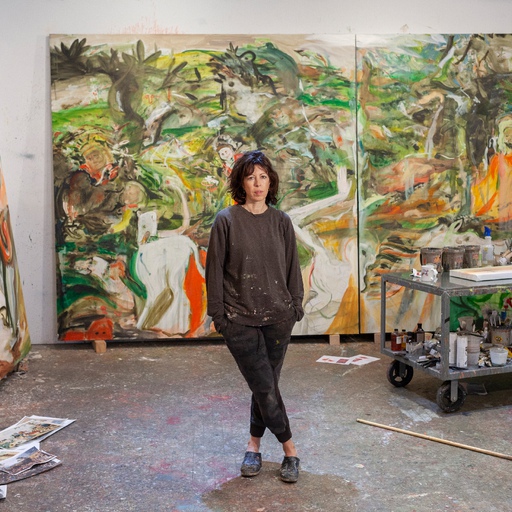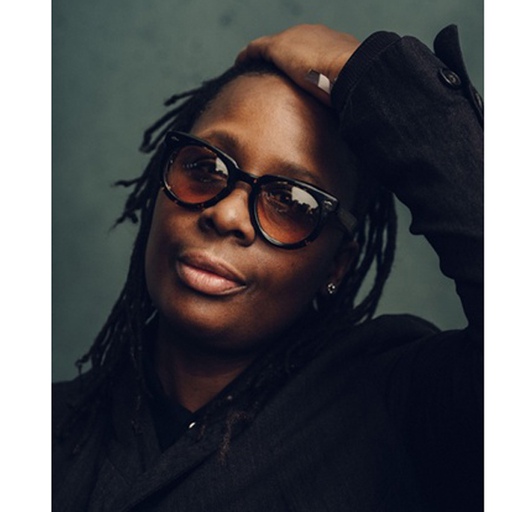Coming just over a month after Hurricane Sandy smashed its way through Chelsea, this year's VIP opening of Art Basel Miami Beach held more suspense than usual. Would sales be strong enough to help those dealers most affected by the storm recover? When the doors opened yesterday morning, there wasn't the headlong surge of collectors seen in the past—fair organizers limited VIP cards this year in an effort to tamp down the frenzy. But, happily, the combination of a market buoyed by November's record contemporary art auctions and the fair's tight selection of high-quality, if perhaps unusually safe, art led to what was reported as excellent commerce across the board—though few mammoth sales.
One relieved gallery was Casey Kaplan, which saw its basement art storage area flooded during the storm and an entire show's worth of work by the newly signed 76-year-old artist Giorgio Griffa—it was to be his first display in New York in 40 years—damaged. That work is now with a conservator, but in the meantime the gallery brought three elegant paintings by Griffa to the fair, all simple, delicately colored brushstrokes on raw fabric.
"His work has the same relationship with nature and spiritually as the Arte Povera artists but was not grouped with them because he is a painter," said the gallery's Loring Randolph. "His works always look unfinished because he believes that the paintings are universal, and that his brush is simply a conduit for paintings that have been around for thousands of years." The works were between $17,000 and $40,000, and one found a buyer, as did a bright $67,000 Liam Gillick sculpture. "We've sold something by every artist we brought," Randolf said. A Marlo Pascual was on hold.
Paul Kasmin Gallery, meanwhile, was having a spectacular opening day. In the first half hour a set of five new $65,000 Ivan Navarro sculptures—canisters containing the artist's trademark eternal mirrors and the word "shout," "scream," "call," "whisper," or "mouth"—sold to a Berlin-based collector, and a few hours later only two of the 15 versions on offer remained available. A $95,000 mirror-polished abstract steel sculpture by Saint Clair Cemin sold to a Brazilian collector as well. The booth was also replete with new works by the gallery’s major artists: two monochromes by Kenny Scharf at $125,000 apiece, two "Yentyl" paintings by Deborah Kass at $85,000 each, and a portrait by new gallery artist Taner Ceylan, a highly sought-after Turkish painter who explores the theme of Orientalism in his work. (The painting in question depicted Esma Sultan, a notorious Ottoman princess who would bring young men to her home, seduce them, and then kill them.)
"I have to say normally I look around the fair a good deal, but I haven't been able to because it's so lively," said Paul Kasmin. "I brought quite a lot of artists whom I have never shown at the fair, like Saint Clair Celmin, and it's very popular. And often times I make sure to bring older work but this year I brought all contemporary. It was a good idea." Well, almost all contemporary: a $1.2 million Warhol portrait on one wall lent some historical heft.
A more even mix of old and new could be found at Rhona Hoffman Gallery, where one corner saw a trio of richly textural 1970s wall pieces by Robert Heinecken juxtaposed with the flatness of exquisite, barely-there drawings by Fred Sandback. But the most activity seemed to be directed toward younger artists, with a new Luis Gispert photo of an airplane cockpit selling for $35,000, a Siebren Versteeg painting for $14,000, and a piece by Xaviera Simmons—whom Rhona Hoffman discovered at a Studio Museum in Harlem show and has begun showing at fairs, though she doesn't represent her—for between $15,000 and $20,000. There was also a room filled with new paintings by the Italian avant-garde artist Carla Accardi that was attracting significant attention, according to a gallery representative.
At Leslie Tonkonow Gallery a massive 1961 piece by Fluxus pioneer Robert Watts called Table for Suicide Event (aka Band Aid Event) commanded center stage. Consisting of a table holding a deck of cards, a razor blade, band-aids, a phone, and other objects, the macabre piece was boxed into a glass vitrine but a viewer could sit at the table and interact with its contents (with a phone dialed in to a suicide hotline). The $250,000 piece was on reserve for a museum collection. Also on view was a new series of $25,000 works by Laurel Nakadate, who blew up tourist photos she took in Iceland, covered her hands and feet with black ink, and threw herself passionately at the photograph, clawing and kicking and kissing it to leave streaks of ink and lipstick. Spread across other walls were a number of different works by early land-art maverick Agnes Denes, including a suite of three intricate drawings for $150,000 and photo documentation of a piece 1982 piece she did where she grew wheat in New York's Battery Park, harvested it, and distributed it to hungry people around the world.
Elsewhere in the fair, brisk sales could be noted at Fortes Villaqua, which had sold two $130,000 paintings by Os Gemeos, and Marianne Boesky Gallery, which sold "a few" Diana al-Hadid sculptures for prices between $75,000 and $85,000, a lovely salt-encrusted Pier Paolo Calzolari for $250,000, and five paintings by Russian artist Kon Trubkovich (three of his mother for $25,000 apiece, two of Ronald Reagan for $5,000) found buyers. Almine Rech parted with a particularly restrained Francesco Vezzoli portrait ($160,000) and two Alex Israel paintings for $60,000, while a suite of four works by the young Berlin-based artist Mattias Bitzer were on reserve. (The gallery also had a puckish $250,000 Richard Prince from his new series, in which he takes the plastic rings from six-packs, sticks them on canvas, and paints over them in what seems like a diabolical answer to Christopher Wool.)
At Metro Pictures, a giant diptych of a knight in armor and a pinup girl sold for $250,000, while a $450,000 Cindy Sherman—from her new series, in which she takes photos of landscapes on the island Stromboli, overlays an image of herself onto the work, and then digitally alters them to look like paintings—was on reserve. Salon 94 took a focused approach to the fair, bringing mini-shows by Jon Kessler and Huma Bhaba. All of the Bhaba works, including a $50,000 bronze of a pair of feet and a $35,000 photo drawing, sold, as well as two of Kessler's deeply disconcerting sculptures of young animatronic boys, with their eyes firmly shut, manipulating Apple products (priced at between $35,000 and $45,000).
David Zwirner Gallery brought a varied slate to the fair, with a $45,000 plastic sculpture by Light-and-Space artist DeWain Valentine, an early $1.5 million Neo Rausch, a $180,000 work on paper by Lisa Yuskavage (a painting of hers sold in the fair's first minutes), a $300,000 Thomas Ruff (sold), and a room of work by Francis Alÿs, including pieces from his recent Documenta outing and a self-portrait he commissioned from a Mexican poster painter in true Kippernbergian style (priced between $150,000 and $650,000, all had sold). A room filled with Minimalist works by Donald Judd, Dan Flavin, Fred Sandback, and others also showcased the gallery's unimpeachable authority when it comes to that period.
Luhring Augustine had a stunning booth, with a $1.5 million Albert Oehlen painting gesturing wildly at a far quieter, yet amply dynamic, $275,000 painting across the stand by Philip Taaffe, a newcomer to the gallery. "A lot of people only know his work from the ‘90s so its nice to see some of the paintings from the last couple of years," the gallery's Kristen Becker said of the artist. A notably phallic Cady Noland made a rare art-fair appearance in the booth—a welcome sight also found at D'Amelio Terras, where three stunning examples are on view. Priced at $75,000 and from an edition of 30, Luhring Augustine's sculpture made a compelling argument that the reclusive artist should allow more of her indispensable work to appear at fairs—so that consequently she might have a greater presence in museum collections some day. Elsewhere in the booth was a stellar Christopher Wool work on paper that he made with the same acrylic paint from his sign paintings. "He's the kind of artist who can do anything he wants, but my favorite thing about Christopher is when he shows restraint, and this really has the artist's hand in it," Becker said of the $275,000 work.
At Sadie Coles, a towering sculpture-cum-portable-home-cum-performance space by Turner Prize nominee Spartacus Chetwynd dominated the booth, rising into the air like a house of cards made from glass and steel. Priced at $65,000, it was matched in intensity by two glowing yellow Ugo Rondinone tondo paintings that seemed to emit light ($320,000), displayed, as the artist prefers, with a pair of his superbly convincing painted lead apples on the floor as a kind of punctuation. At $28,000, the apples sold quickly, as did much else in the booth. "Quite a lot has sold," said Sadie Coles. "The quality of collectors has been very impressive—it's better than last year. But"—she paused—"I still have to sell the house."
Art MarketBrisk Sales Spread Relief at Art Basel Miami Beach
